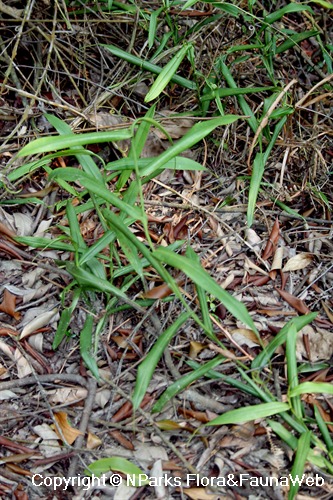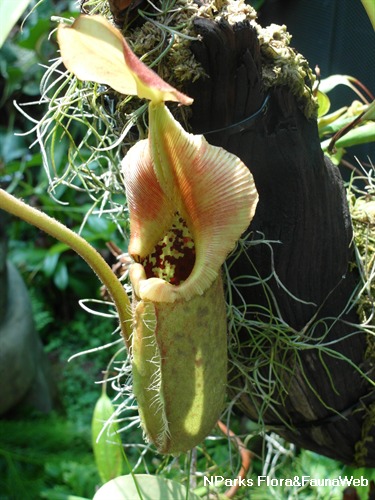
Back
Nepenthes gracilis Korth.
| Family Name: | Nepenthaceae |
| Synonyms: | Nepenthes korthalsiana, Nepenthes longinodis, Nepenthes laevis, Nepenthes angustifolia |
| Common Name: | Slender Pitcher Plant, Periok Kera, Monkey Cup, 猪笼草 |
This native pitcher plant species is commonly found in Singapore.
Name
Classifications and Characteristics
| Plant Division | Angiosperms (Flowering Seed Plants) (Dicotyledon) |
|---|---|
| Plant Growth Form | Climber |
| Lifespan (in Singapore) | Perennial |
| Mode of Nutrition | Autotrophic, Heterotrophic (Insectivorous / Carnivorous) |
| Maximum Height | 2 m to 6 m |
Biogeography
| Native Distribution | Thailand, Sumatra, Peninsular Malaysia, Singapore, Borneo, Sulawesi |
|---|---|
| Native Habitat | Terrestrial (Secondary Rainforest) |
| Preferred Climate Zone | Tropical |
| Local Conservation Status | Native to Singapore (Least Concern (LC)) |
Description and Ethnobotany
| Growth Form | It is a climber up to 6 m long which adopts a trailing habit in the absence of vertical support structures. |
|---|---|
| Foliage | The pitchers are modified leaves which trap small, crawling insects, such as ants. Insects seeking shelter from the rain under the pitcher lid may find themselves knocked into the pitcher's digestive fluid by rain drops falling hard against the lid. Pitchers in the lower part of the plant vary in colour from orange, maroon, red or green, while those in the upper part are usually green. The leaves are smooth, stalkless and the lower part of the leaf blade partially wraps around the stem. |
| Stems | The upper portion of the reddish purple stem is angular. |
| Flowers | Male and female flowers occur on separate individuals. They lack petals, but have sepals where nectar is deposited by nearby nectaries. |
| Habitat | It occurs in lowland peat swamp forests or disturbed areas with poor soils. |
| Etymology | The genus Nepenthes means the numbing or relieving of pain in Greek. The specific epithet gracilis means slender in Latin referring to the slender shape of the pitcher. |
| Ethnobotanical Uses | Medicinal: Powdered root used in Malay folk medicine to treat gastrointestinal disorders, stomach ache, dysentery, and as poultice. Stem infusion used to relieve coughs and fevers. Also thought to be effective as emetic to induce vomiting. Fluids from unopened pitchers used as laxatives, as well as to treat burns and skin disorders. Cultural / Religious: Pitchers reportedly used by Malay bomohs (shamans) for spirit exorcisms and religious rites to bring rain. |
Landscaping Features
| Landscape Uses | Container Planting, Suitable for Hanging Baskets |
|---|---|
| Thematic Landscaping | Carnivorous Garden, Naturalistic Garden |
Fauna, Pollination and Dispersal
| Pollination Method(s) | Biotic (Fauna) (Insects (Butterfly, Moth), Insects (Ant, Beetle, Fly, Thrip, Wasp)) |
|---|---|
| Seed or Spore Dispersal | Abiotic (Explosive Dehiscence) |
Plant Care and Propagation
| Light Preference | Semi-Shade, Full Sun |
|---|---|
| Water Preference | Moderate Water |
| Plant Growth Rate | Moderate |
| Rootzone Tolerance | Well-Drained Soils, Poor Infertile Soils, Acidic (low pH) Soils, Waterlogged Soils (Drains Site), Easy to Grow |
| Maintenance Requirements | Moderate |
| Propagation Method | Seed, Stem Cutting |
Foliar
| Foliage Retention | Evergreen |
|---|---|
| Mature Foliage Colour(s) | Green |
| Mature Foliage Texture(s) | Smooth, Leathery |
| Foliar Modification | Pitcher Trap |
| Foliar Type | Simple / Unifoliate |
| Foliar Arrangement Along Stem | Alternate |
| Foliar Shape(s) | Non-Palm Foliage (Oblong) |
| Foliar Venation | Pinnate / Net |
| Foliar Margin | Entire |
| Foliar Apex - Tip | Acuminate |
| Typical Foliar Area | Microphyll ( 2.25cm2 - 20.25 cm2 ) |
| Prominent Young Flush Colour(s) Remarks | Velvety Reddish-Brown |
Non - Foliar and Storage
| Stem Type & Modification | Herbaceous |
|---|---|
| Root Type | Underground (Fibrous Root) |
Floral (Angiosperm)
| Flower & Plant Sexuality | Unisexual Flowers , Dioecious |
| Flower Grouping | Cluster / Inflorescence |
|---|
| Inflorescence Type | Raceme |
| Flowering Period | Once Yearly |
| Flowering Habit | Polycarpic |
Fruit, Seed and Spore
| Mature Fruit Colour(s) | Brown |
|---|---|
| Fruit Classification | Simple Fruit |
| Fruit Type | Dehiscent Dry Fruit , Capsule |
Image Repository
Others
| Master ID | 162 |
|---|---|
| Species ID | 1458 |
| Flora Disclaimer | The information in this website has been compiled from reliable sources, such as reference works on medicinal plants. It is not a substitute for medical advice or treatment and NParks does not purport to provide any medical advice. Readers should always consult his/her physician before using or consuming a plant for medicinal purposes. |


















.jpg)

.jpg)